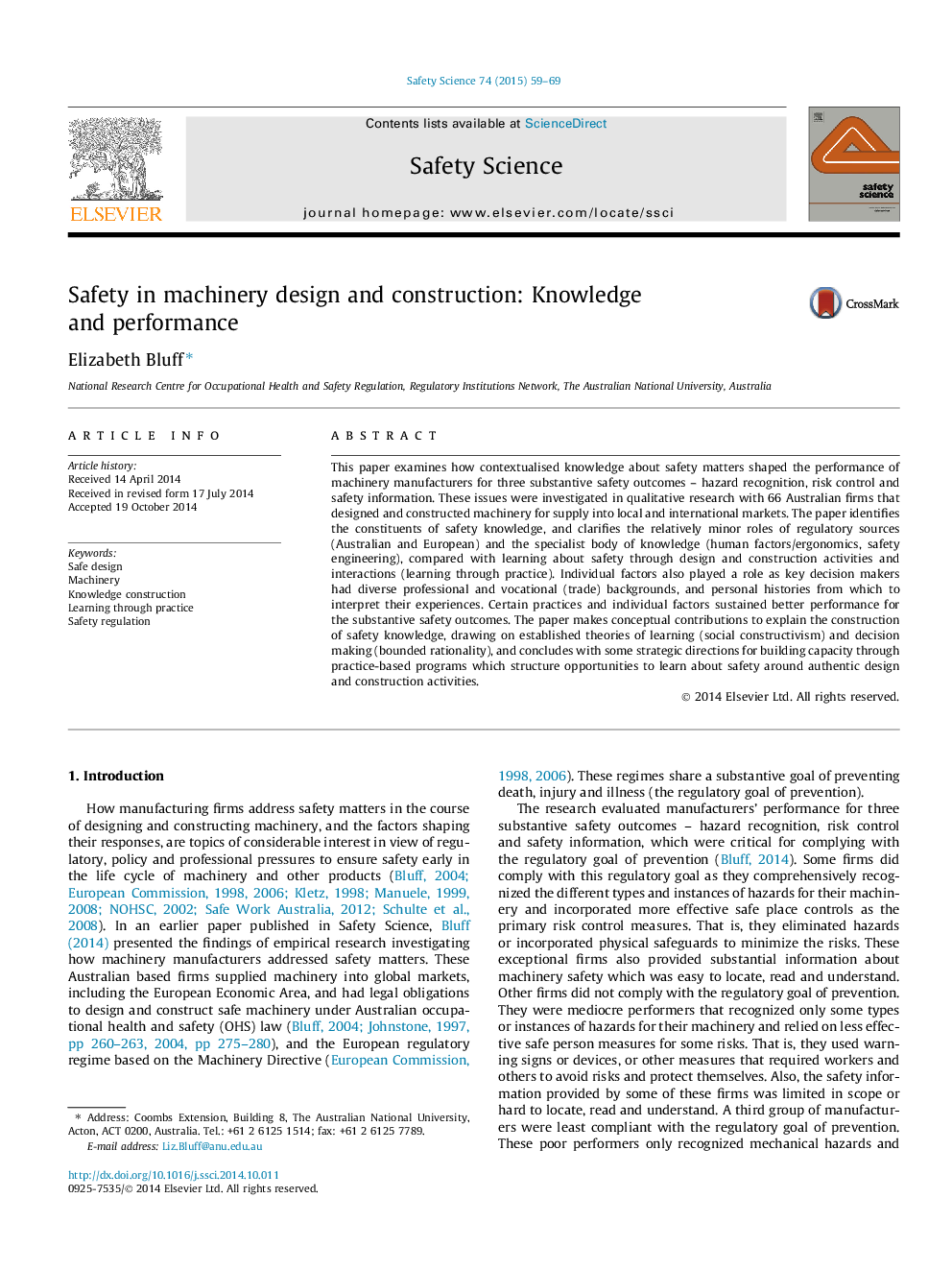| کد مقاله | کد نشریه | سال انتشار | مقاله انگلیسی | نسخه تمام متن |
|---|---|---|---|---|
| 6975958 | 1453397 | 2015 | 11 صفحه PDF | دانلود رایگان |
عنوان انگلیسی مقاله ISI
Safety in machinery design and construction: Knowledge and performance
ترجمه فارسی عنوان
ایمنی در طراحی و ساخت ماشین آلات: دانش و عملکرد
دانلود مقاله + سفارش ترجمه
دانلود مقاله ISI انگلیسی
رایگان برای ایرانیان
کلمات کلیدی
طراحی ایمن، دستگاه، ساخت دانش، یادگیری از طریق تمرین، مقررات ایمنی،
ترجمه چکیده
این مقاله به بررسی اینکه چگونه اطلاعات محرمانه در مورد مسائل ایمنی، عملکرد سازندگان ماشین آلات را برای سه نتیجه ایمنی اساسی - شناسایی خطر، کنترل ریسک و اطلاعات ایمنی شکل داد. این مسائل در تحقیقات کیفی با 66 شرکت استرالیا مورد بررسی قرار گرفت که ماشین آلات را برای عرضه در بازارهای محلی و بین المللی طراحی و ساخته شد. این مقاله مواد تشکیل دهنده دانش ایمنی را شناسایی می کند و نقش های نسبتا جزئی منابع قانونی (استرالیا و اروپا) و دانش تخصصی (عوامل انسانی / ارگونومی، مهندسی ایمنی) را در مقایسه با یادگیری ایمنی از طریق فعالیت های طراحی و ساخت و ساز تعاملات (یادگیری از طریق تمرین). عوامل فردی نیز نقش مهمی را ایفا می کردند زیرا تصمیم گیرندگان کلیدی زمینه های حرفه ای و حرفه ای (تجاری) و تاریخ های شخصی را دارند که از آن تجربیات خود را تفسیر می کنند. بعضی از شیوه ها و عوامل فردی عملکرد بهتر برای نتایج ایمنی اساسی را در بر گرفت. این مقاله مشارکت مفهومی را برای توضیح ساختن دانش ایمنی، بر پایه نظریه های مبتنی بر یادگیری (ساخت سازگاری اجتماعی) و تصمیم گیری (محدودیت عقلانیت)، و با برخی از قواعد استراتژیک برای ایجاد ظرفیت از طریق برنامه های مبتنی بر عمل که فرصت های یادگیری را تشکیل می دهند، در مورد ایمنی در مورد طراحی و فعالیت های ساختمانی معتبر.
موضوعات مرتبط
مهندسی و علوم پایه
مهندسی شیمی
بهداشت و امنیت شیمی
چکیده انگلیسی
This paper examines how contextualised knowledge about safety matters shaped the performance of machinery manufacturers for three substantive safety outcomes - hazard recognition, risk control and safety information. These issues were investigated in qualitative research with 66 Australian firms that designed and constructed machinery for supply into local and international markets. The paper identifies the constituents of safety knowledge, and clarifies the relatively minor roles of regulatory sources (Australian and European) and the specialist body of knowledge (human factors/ergonomics, safety engineering), compared with learning about safety through design and construction activities and interactions (learning through practice). Individual factors also played a role as key decision makers had diverse professional and vocational (trade) backgrounds, and personal histories from which to interpret their experiences. Certain practices and individual factors sustained better performance for the substantive safety outcomes. The paper makes conceptual contributions to explain the construction of safety knowledge, drawing on established theories of learning (social constructivism) and decision making (bounded rationality), and concludes with some strategic directions for building capacity through practice-based programs which structure opportunities to learn about safety around authentic design and construction activities.
ناشر
Database: Elsevier - ScienceDirect (ساینس دایرکت)
Journal: Safety Science - Volume 74, April 2015, Pages 59-69
Journal: Safety Science - Volume 74, April 2015, Pages 59-69
نویسندگان
Elizabeth Bluff,
